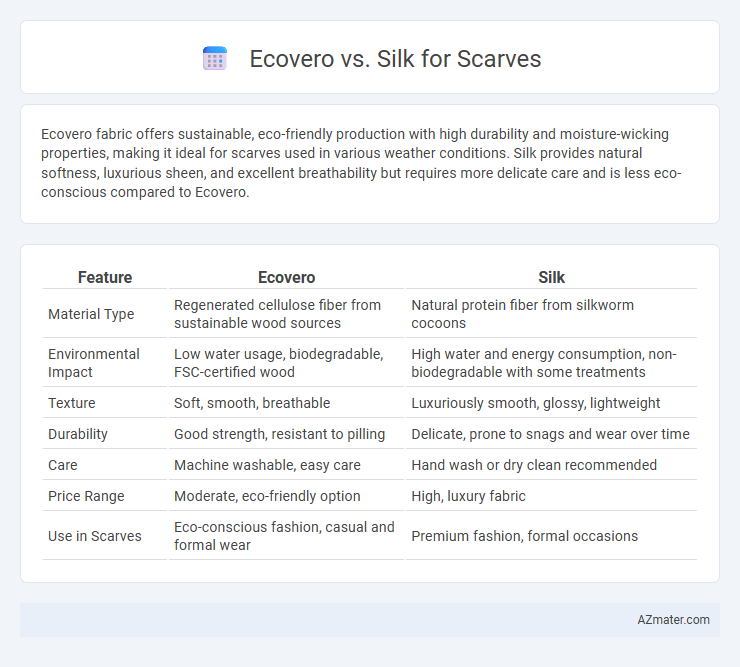Ecovero fabric offers sustainable, eco-friendly production with high durability and moisture-wicking properties, making it ideal for scarves used in various weather conditions. Silk provides natural softness, luxurious sheen, and excellent breathability but requires more delicate care and is less eco-conscious compared to Ecovero.
Table of Comparison
| Feature | Ecovero | Silk |
|---|---|---|
| Material Type | Regenerated cellulose fiber from sustainable wood sources | Natural protein fiber from silkworm cocoons |
| Environmental Impact | Low water usage, biodegradable, FSC-certified wood | High water and energy consumption, non-biodegradable with some treatments |
| Texture | Soft, smooth, breathable | Luxuriously smooth, glossy, lightweight |
| Durability | Good strength, resistant to pilling | Delicate, prone to snags and wear over time |
| Care | Machine washable, easy care | Hand wash or dry clean recommended |
| Price Range | Moderate, eco-friendly option | High, luxury fabric |
| Use in Scarves | Eco-conscious fashion, casual and formal wear | Premium fashion, formal occasions |
Overview: Ecovero vs Silk Scarves
Ecovero scarves are crafted from sustainable viscose fibers derived from certified renewable wood sources, offering an eco-friendly alternative to traditional fabrics. Silk scarves boast natural protein fibers produced by silkworms, renowned for their luxurious softness, sheen, and breathability. While Ecovero emphasizes environmental responsibility and moisture-wicking properties, silk provides unmatched elegance and durability valued in high-end fashion accessories.
What is Ecovero? Key Features
Ecovero is a sustainable viscose fiber made from certified renewable wood sources, designed to reduce environmental impact compared to conventional viscose. Its key features include lower water and energy consumption, reduced greenhouse gas emissions, and certification by the EU Ecolabel, ensuring eco-friendly production standards. Ecovero scarves offer a soft, breathable texture with enhanced durability, making them a responsible alternative to traditional silk scarves.
Silk Fabric: Origins and Properties
Silk fabric originates from the protein fiber produced by silkworms, primarily from the Bombyx mori species, known for its luxurious softness, natural sheen, and excellent moisture-wicking properties. Ecovero, a sustainable viscose fiber made from certified renewable wood sources, provides an eco-friendly alternative but lacks the unique strength and elasticity inherent to silk. The intrinsic properties of silk, including its hypoallergenic nature and thermal regulation, make it a superior choice for scarves requiring both comfort and elegance.
Sustainability: Ecovero Against Silk
Ecovero fibers, derived from sustainably sourced wood pulp, boast a lower environmental impact compared to traditional silk production, which involves resource-intensive sericulture and often ethical concerns regarding silkworms. The eco-friendly manufacturing process of Ecovero reduces water consumption and greenhouse gas emissions significantly, positioning it as a more sustainable alternative for scarf materials. While silk offers a luxurious texture, Ecovero's certified renewable sourcing supports circular fashion initiatives and reduces biodiversity threats associated with conventional silk farming.
Comfort and Wearability Comparison
Ecovero fabric offers exceptional breathability and moisture-wicking properties, making scarves comfortable for extended wear in various climates. Silk provides a naturally smooth texture with excellent temperature regulation, ensuring softness against the skin and a luxurious feel. While Ecovero excels in sustainability and durability, silk remains preferred for its lightweight elegance and superior drapeability.
Aesthetic Appeal: Texture and Shine
Ecovero fabric offers a smooth texture with a subtle matte finish, providing a natural and understated elegance for scarves. Silk is renowned for its lustrous shine and soft, luxurious feel, creating a vibrant and eye-catching aesthetic. Choosing between Ecovero and silk scarves depends on whether a muted sophistication or a glossy, high-sheen look is preferred.
Durability and Care Instructions
Ecovero scarves, made from sustainable viscose fibers, offer excellent durability with enhanced resistance to wear and tear compared to conventional viscose, ensuring long-lasting softness and shape retention. Silk scarves require delicate care, including hand washing or dry cleaning, to maintain their luxurious texture and prevent damage, while Ecovero scarves are often machine washable on gentle cycles, providing easier maintenance. The robust fiber structure of Ecovero supports frequent use without significant degradation, making it a practical choice for those seeking both sustainability and resilience in scarves.
Skin Friendliness: Sensitivity Analysis
Ecovero fibers used in scarves exhibit superior skin friendliness due to their organic, sustainably sourced materials that reduce allergic reactions and irritation, making them ideal for sensitive skin. Silk, renowned for its smooth texture, naturally offers hypoallergenic properties but may occasionally cause discomfort for individuals with extreme sensitivity or certain protein allergies. Sensitivity analysis shows Ecovero scarves are generally better tolerated in prolonged wear scenarios, while silk remains preferred for luxury softness, highlighting Ecovero's advantage in dermatological comfort and eco-conscious textile innovation.
Price Point and Accessibility
Ecovero fabric scarves generally have a higher price point compared to silk scarves due to sustainable production processes and eco-friendly certifications. Silk scarves are widely accessible in various retail outlets and online platforms, offering a broad range of affordable options. Ecovero scarves might be less available, often found in specialty or eco-conscious stores, limiting immediate accessibility.
Which is Better for Scarves? Final Thoughts
Ecovero and Silk differ significantly in sustainability and texture when used for scarves. Ecovero, a certified sustainable viscose derived from responsibly managed wood sources, offers eco-friendly advantages with a soft, breathable feel but lacks silk's natural sheen and luxurious smoothness. Silk remains unmatched in elegance and durability, ideal for premium scarves, while Ecovero provides a more affordable, environmentally conscious alternative with comparable comfort.

Infographic: Ecovero vs Silk for Scarf
 azmater.com
azmater.com